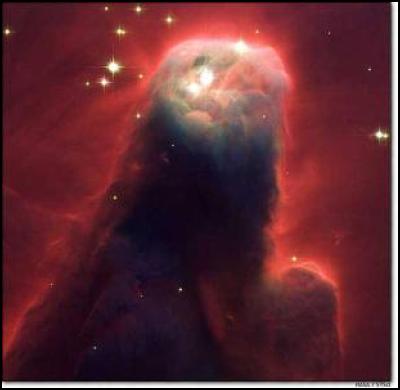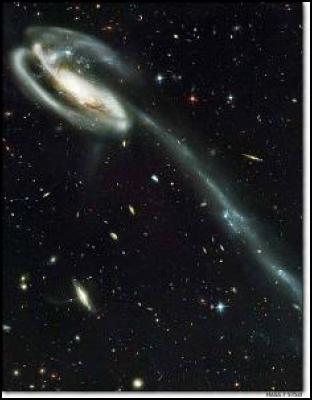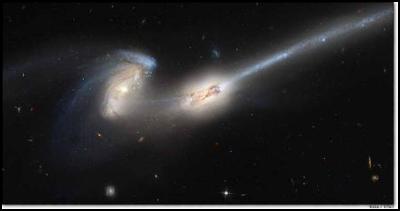First Four Views Of Universe From Upgraded Hubble
"Remarkable, breathtaking" are words jubilant astronomers are using to describe the first four views of the universe taken by the Hubble Space Telescope's new Advanced Camera for Surveys, released by NASA today.
The new camera was installed on Hubble by astronauts during a shuttle mission last March, the fourth Hubble Space Telescope servicing mission. During five of the most challenging spacewalks ever attempted, the crew successfully upgraded the orbiting telescope with the new camera, a new power unit, new solar arrays and an experimental cooling unit for an infrared camera. Hubble managers say the orbiting telescope has been operating superbly since the servicing mission.

Resembling a nightmarish beast rearing its head from a crimson sea, this monstrous object is actually an innocuous pillar of gas and dust. Called the Cone Nebula (NGC 2264) — so named because, in ground-based images, it has a conical shape — this giant pillar resides in a turbulent star-forming region.
This picture, taken by the newly installed Advanced Camera for Surveys (ACS) aboard NASA's Hubble Space Telescope, shows the upper 2.5 light-years of the nebula, a height that equals 23 million roundtrips to the Moon. The entire nebula is 7 light-years long. The Cone Nebula resides 2,500 light-years away in the constellation Monoceros.
Radiation from hot, young stars [located beyond the top of the image] has slowly eroded the nebula over millions of years. Ultraviolet light heats the edges of the dark cloud, releasing gas into the relatively empty region of surrounding space. There, additional ultraviolet radiation causes the hydrogen gas to glow, which produces the red halo of light seen around the pillar. A similar process occurs on a much smaller scale to gas surrounding a single star, forming the bow-shaped arc seen near the upper left side of the Cone. This arc, seen previously with the Hubble telescope, is 65 times larger than the diameter of our solar system. The blue-white light from surrounding stars is reflected by dust. Background stars can be seen peeking through the evaporating tendrils of gas, while the turbulent base is pockmarked with stars reddened by dust.
Over time, only the densest regions of the Cone will be left. Inside these regions, stars and planets may form.
The Cone Nebula is a cousin of the M16 pillars, which the Hubble telescope imaged in 1995. Monstrous pillars of cold gas, like the Cone and M16, are common in large regions of star birth. Astronomers believe that these pillars are incubators for developing stars.
ACS made this observation on April 2, 2002. The color image is constructed from three separate images taken in blue, near-infrared, and hydrogen-alpha filters.

Against a stunning backdrop of thousands of galaxies, this odd-looking galaxy with the long streamer of stars appears to be racing through space, like a runaway pinwheel firework.
This picture of the galaxy UGC 10214 was taken by the Advanced Camera for Surveys (ACS), which was installed aboard NASA's Hubble Space Telescope in March during Servicing Mission 3B. Dubbed the "Tadpole," this spiral galaxy is unlike the textbook images of stately galaxies. Its distorted shape was caused by a small interloper, a very blue, compact galaxy visible in the upper left corner of the more massive Tadpole. The Tadpole resides about 420 million light-years away in the constellation Draco.
Seen shining through the Tadpole's disk, the tiny intruder is likely a hit-and-run galaxy that is now leaving the scene of the accident. Strong gravitational forces from the interaction created the long tail of debris, consisting of stars and gas that stretch out more than 280,000 light-years.
Numerous young blue stars and star clusters, spawned by the galaxy collision, are seen in the spiral arms, as well as in the long "tidal" tail of stars. Each of these clusters represents the formation of up to about a million stars. Their color is blue because they contain very massive stars, which are 10 times hotter and 1 million times brighter than our Sun. Once formed, the star clusters become redder with age as the most massive and bluest stars exhaust their fuel and burn out. These clusters will eventually become old globular clusters similar to those found in essentially all halos of galaxies, including our own Milky Way.
Two prominent clumps of young bright blue stars in the long tail are separated by a "gap" — a section that is fainter than the rest of the tail. These clumps of stars will likely become dwarf galaxies that orbit in the Tadpole's halo.
The galactic carnage and torrent of star birth are playing out against a spectacular backdrop: a "wallpaper pattern" of 6,000 galaxies. These galaxies represent twice the number of those discovered in the legendary Hubble Deep Field, the orbiting observatory's "deepest" view of the heavens, taken in 1995 by the Wide Field and Planetary Camera 2. The ACS picture, however, was taken in one-twelfth the time it took to observe the original Hubble Deep Field. In blue light, ACS sees even fainter objects than were seen in the "deep field." The galaxies in the ACS picture, like those in the deep field, stretch back to nearly the beginning of time. They are a myriad of shapes and represent fossil samples of the universe's 13-billion-year evolution.
The ACS image is so sharp that astronomers can identify distant colliding galaxies, the "building blocks" of galaxies, an exquisite "Whitman's Sampler" of galaxies, and many extremely faraway galaxies.
ACS made this observation on April 1 and 9, 2002. The color image is constructed from three separate images taken in near-infrared, orange, and blue filters.

The Advanced Camera for Surveys (ACS), the newest camera on NASA's Hubble Space Telescope, has captured a spectacular pair of galaxies engaged in a celestial dance of cat and mouse or, in this case, mouse and mouse.
Located 300 million light-years away in the constellation Coma Berenices, the colliding galaxies have been nicknamed "The Mice" because of the long tails of stars and gas emanating from each galaxy. Otherwise known as NGC 4676, the pair will eventually merge into a single giant galaxy.
The image shows the most detail and the most stars that have ever been seen in these galaxies. In the galaxy at left, the bright blue patch is resolved into a vigorous cascade of clusters and associations of young, hot blue stars, whose formation has been triggered by the tidal forces of the gravitational interaction. Streams of material can also be seen flowing between the two galaxies.
The clumps of young stars in the long, straight tidal tail [upper right] are separated by fainter regions of material. These dim regions suggest that the clumps of stars have formed from the gravitational collapse of the gas and dust that once occupied those areas. Some of the clumps have luminous masses comparable to dwarf galaxies that orbit in the halo of our own Milky Way Galaxy.
Computer simulations by astronomers Josh Barnes (University of Hawaii) and John Hibbard (National Radio Astronomy Observatory, Charlottesville, Va.) show that we are seeing two nearly identical spiral galaxies approximately 160 million years after their closest encounter. The long, straight arm is actually curved, but appears straight because we see it edge-on. The simulations also show that the pair will eventually merge, forming a large, nearly spherical galaxy (known as an elliptical galaxy). The stars, gas, and luminous clumps of stars in the tidal tails will either fall back into the merged galaxies or orbit in the halo of the newly formed elliptical galaxy.
The Mice presage what may happen to our own Milky Way several billion years from now when it collides with our nearest large neighbor, the Andromeda Galaxy (M31).
This picture is assembled from three sets of images taken on April 7, 2002, in blue, orange, and near-infrared filters.

A watercolor fantasyland? No. It's actually an image of the center of the Omega Nebula, a hotbed of newly born stars wrapped in colorful blankets of glowing gas and cradled in an enormous cold, dark hydrogen cloud. This stunning picture was taken by the newly installed Advanced Camera for Surveys (ACS) aboard NASA's Hubble Space Telescope.
The region of the nebula shown in this photograph is about 3,500 times wider than our solar system. The area represents about 60 percent of the total view captured by ACS. The nebula, also called M17 and the Swan Nebula, resides 5,500 light-years away in the constellation Sagittarius.
Like its famous cousin in Orion, the Swan Nebula is illuminated by ultraviolet radiation from young, massive stars, located just beyond the upper right corner of the image. Each star is about six times hotter and 30 times more massive than the Sun. The powerful radiation from these stars evaporates and erodes the dense cloud of cold gas within which the stars formed. The blistered walls of the hollow cloud shine primarily in the blue, green, and red light emitted by excited atoms of hydrogen, nitrogen, oxygen, and sulfur. Particularly striking is the rose-like feature, seen to the right of center, which glows in the red light emitted by hydrogen and sulfur.
As the infant stars evaporate the surrounding cloud, they expose dense pockets of gas that may contain developing stars. Because these dense pockets are more resistant to the withering radiation than the surrounding cloud, they appear as sculptures in the walls of the cloud or as isolated islands in a sea of glowing gas. One isolated pocket is seen at the center of the brightest region of the nebula and is about 10 times larger than our solar system. Other dense pockets of gas have formed the remarkable feature jutting inward from the left edge of the image, which resembles the famous Horsehead Nebula in Orion.
ACS made this observation on April 1 and 2, 2002. The color image is constructed from four separate images taken in these filters: blue, near infrared, hydrogen alpha, and doubly ionized oxygen.


 Transpower: Major Electricity Development For Western Bay Of Plenty A Step Closer
Transpower: Major Electricity Development For Western Bay Of Plenty A Step Closer Alcohol Beverages Council: Turning The Tide - New Zealanders Unite To Curb Harmful Drinking
Alcohol Beverages Council: Turning The Tide - New Zealanders Unite To Curb Harmful Drinking University of Auckland Business School: Economists Urge Action To Prevent ‘AI Poverty Traps’
University of Auckland Business School: Economists Urge Action To Prevent ‘AI Poverty Traps’ Bill Bennett: Australian warship takes rural fixed wireless broadband offline
Bill Bennett: Australian warship takes rural fixed wireless broadband offline NZ Telecommunications Forum - TCF: New Zealand Is Saying Goodbye To 3G: Are You Ready For The Change?
NZ Telecommunications Forum - TCF: New Zealand Is Saying Goodbye To 3G: Are You Ready For The Change? NZ Post: Mānawatia A Matariki - NZ Post Stamps Look To The Stars Ahead Of The Māori New Year
NZ Post: Mānawatia A Matariki - NZ Post Stamps Look To The Stars Ahead Of The Māori New Year


